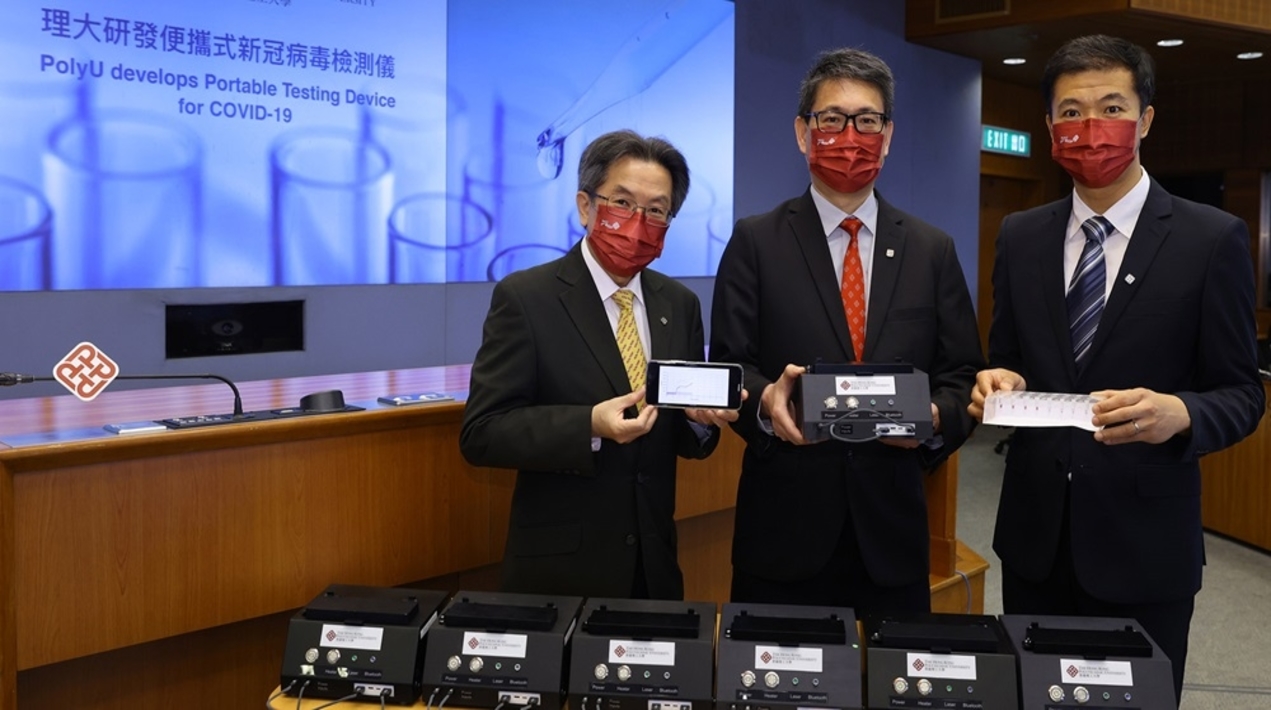
In 2020, an interdisciplinary research team from The Hong Kong Polytechnic University (PolyU) was awarded over HK$2.7 million by the Health and Medical Research Fund (HMRF) to commence research on a portable testing device for COVID-19 (the device).
After a year and a half of extensive work, the team successfully achieved highly sensitive SARS-CoV-2 viral RNA detection based on the combination of reverse transcription-loop-mediated isothermal amplification (RT-LAMP) and gold nanoparticles (as amplification result readout reagent). The clinical sample test results were in full agreement with the reverse transcription-polymerase chain reaction (RT-PCR) standard.
The device accommodates up to six testing samples at one time. Excluding one positive and one negative control sample, up to four samples can be tested at the same time. Once the samples have been collected, tests can be run on-site using the device, without the need to return the samples to the laboratory.
The device provides a constant temperature of 65°C, and the built-in optical system will monitor the precipitation or dispersion of gold nanoparticles (precipitate in positive samples, while remaining dispersed in negative samples). Real-time data will be sent to a mobile app via Bluetooth, and the test results will be analysed and displayed on the screen of the phone.
An increase in the optical signal between 10 and 20 minutes indicates a positive sample, and the shorter the onset time, the higher the viral load in the sample. A positive sample can be confirmed in as short as 25 minutes. The entire test can be completed in about 40 minutes, and the test results can be recognised with bare eyes.
The Vice President (Research and Innovation) of PolyU remarked that the team is grateful to the Food and Health Bureau for their trust in PolyU. With the strong support of the HMRF, PolyU was able to leverage its interdisciplinary strengths to contribute to the Government’s anti-pandemic measures and translate research outcomes into real-life applications, bringing about benefits to the community.
The lead of the research project, Professor YIP Shea-ping, Professor and Head of the Department of Health Technology and Informatics of PolyU, pointed out that using gold nanoparticles as the amplification result readout reagent was the key to the success of this research. The team is pleased to see that their method has attained excellent sensitivity and specificity, which is on par with the current PCR ‘gold standard’.
The portable and rechargeable design of the device enables the entire testing procedures to be performed outside the laboratory, right after on-site sample collection. Dr LEE Ming-hung Thomas, Associate Professor and Associate Head of the Department of Biomedical Engineering of PolyU, is a key member of the research team.
Preliminary environmental sample testing was conducted using gold in the nanoparticle-based RT-LAMP method, even without prior extraction and purification of nucleic acid. The test’s run time was thus shortened, and no large-sized laboratory equipment was required. Nucleic acid testing can be achieved in a handy device, and the accuracy is not affected even with a low viral load. The next important step is to test with human unpurified samples directly, he added.
Both human and environmental samples can be tested in the newly invented device. Besides SARS-CoV-2, other viruses and bacteria can also be detected using this device (primers have to be redesigned). The unit cost of testing is comparatively lower than RT-PCR.
Looking ahead, the team plans to transfer the research outcomes to society by collaborating with industry players to extend the use of such technology to the wider community, in particular places where accurate results are needed within a short period of time (e.g., airports, quarantine facilities, elderly homes, clinics, ports, restaurants, shopping malls, schools, sports and recreational facilities, etc.).
The team also hopes that with this invention in place, management of personal and environmental hygiene can be enhanced, and appropriate control measures can be implemented to reduce the risk of community infection.
















